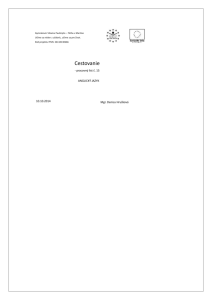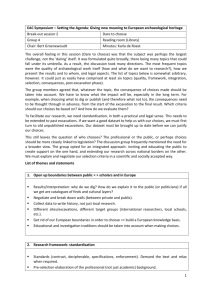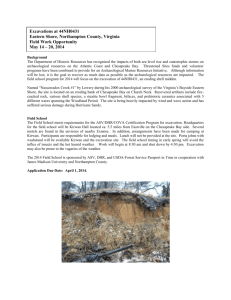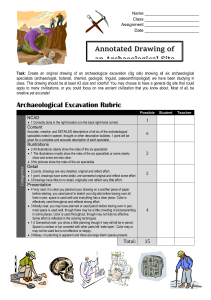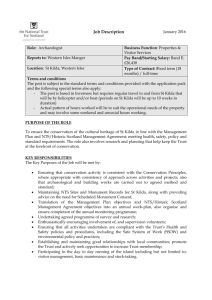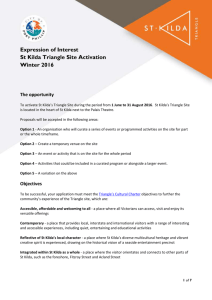WINDS OF CHANGE - The Prehistoric Society
advertisement
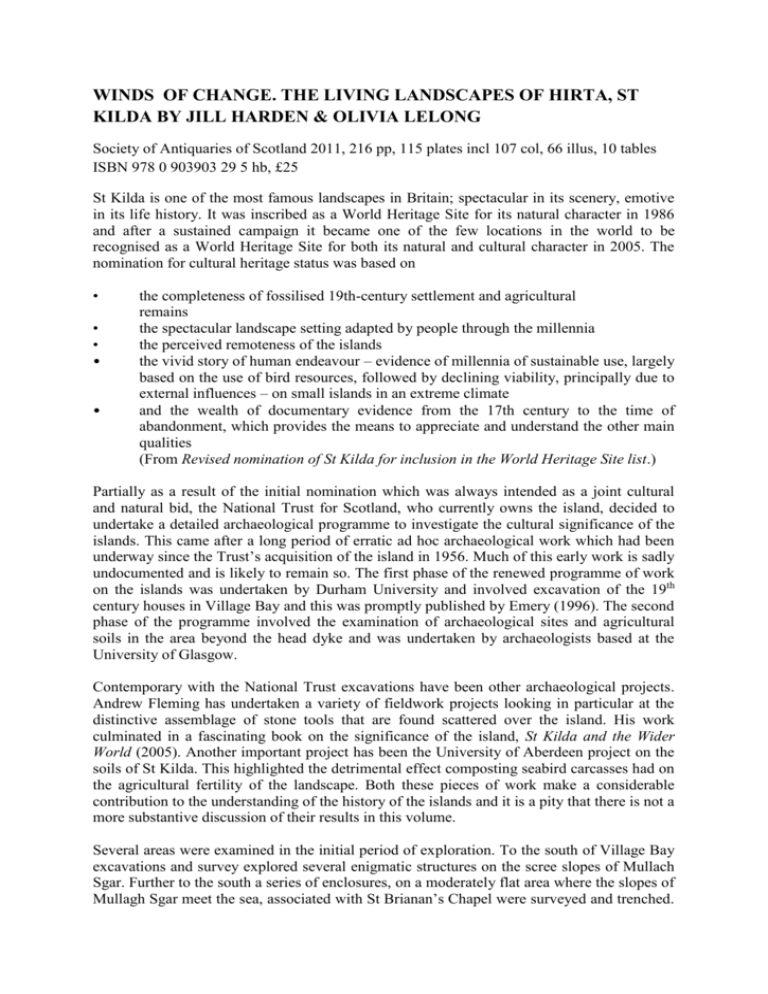
WINDS OF CHANGE. THE LIVING LANDSCAPES OF HIRTA, ST KILDA BY JILL HARDEN & OLIVIA LELONG Society of Antiquaries of Scotland 2011, 216 pp, 115 plates incl 107 col, 66 illus, 10 tables ISBN 978 0 903903 29 5 hb, £25 St Kilda is one of the most famous landscapes in Britain; spectacular in its scenery, emotive in its life history. It was inscribed as a World Heritage Site for its natural character in 1986 and after a sustained campaign it became one of the few locations in the world to be recognised as a World Heritage Site for both its natural and cultural character in 2005. The nomination for cultural heritage status was based on • • • • • the completeness of fossilised 19th-century settlement and agricultural remains the spectacular landscape setting adapted by people through the millennia the perceived remoteness of the islands the vivid story of human endeavour – evidence of millennia of sustainable use, largely based on the use of bird resources, followed by declining viability, principally due to external influences – on small islands in an extreme climate and the wealth of documentary evidence from the 17th century to the time of abandonment, which provides the means to appreciate and understand the other main qualities (From Revised nomination of St Kilda for inclusion in the World Heritage Site list.) Partially as a result of the initial nomination which was always intended as a joint cultural and natural bid, the National Trust for Scotland, who currently owns the island, decided to undertake a detailed archaeological programme to investigate the cultural significance of the islands. This came after a long period of erratic ad hoc archaeological work which had been underway since the Trust’s acquisition of the island in 1956. Much of this early work is sadly undocumented and is likely to remain so. The first phase of the renewed programme of work on the islands was undertaken by Durham University and involved excavation of the 19th century houses in Village Bay and this was promptly published by Emery (1996). The second phase of the programme involved the examination of archaeological sites and agricultural soils in the area beyond the head dyke and was undertaken by archaeologists based at the University of Glasgow. Contemporary with the National Trust excavations have been other archaeological projects. Andrew Fleming has undertaken a variety of fieldwork projects looking in particular at the distinctive assemblage of stone tools that are found scattered over the island. His work culminated in a fascinating book on the significance of the island, St Kilda and the Wider World (2005). Another important project has been the University of Aberdeen project on the soils of St Kilda. This highlighted the detrimental effect composting seabird carcasses had on the agricultural fertility of the landscape. Both these pieces of work make a considerable contribution to the understanding of the history of the islands and it is a pity that there is not a more substantive discussion of their results in this volume. Several areas were examined in the initial period of exploration. To the south of Village Bay excavations and survey explored several enigmatic structures on the scree slopes of Mullach Sgar. Further to the south a series of enclosures, on a moderately flat area where the slopes of Mullagh Sgar meet the sea, associated with St Brianan’s Chapel were surveyed and trenched. To the north east of Village Bay some enigmatic structures at An Lag bho’n Tuath, a high saddle between Oiseval and Conachair, were surveyed and trial trenched. The opportunity was also used to examine the soils in the enclosures found in both areas. In 2004 the concentration on these peripheral areas was reconsidered and work was focussed on the main settlement area in Village Bay. Work commenced with a magnetometer and resistivity survey of the centre of the village. Features identified in this survey were systematically trenched but the excavation was restricted to deturfing and topsoil removal, no ‘archaeology’ was excavated. A large area was also exposed around the previously explored souterrain but again this work involved the exposure but not excavation of the archaeology. The work done on these different areas is more or less laid out in the order I have listed but the order is rather confused by their allocation to different chapters. It is unclear exactly why the description of the structures excavated in the scree slopes of Mullagh Sgar are split between two chapters, 2 and 3, when the structures seem to be very similar in form and function. It is also unclear why a large trench excavated in the area at St Brianan’s Chapel is tacked on to the end of chapter 3 when the immediately adjacent enclosures are the focus of chapter 4. The work at An Lag is similarly split between two separate chapters, 4 and 5, though here the reason is clear; the work on the late enclosures and the soil management issues they address are associated with similar enclosures at St Brianan’s Chapel. However, this link is speculative and it would have made more sense if the excavations at each of these three areas had been organised in separate chapters. It would also have been helpful to have a single plan at the beginning of each of these chapters showing where all the excavated areas were as it is often confusing to have identical plans which show different trenches. Perhaps the most successful excavation was of a small oval structure (structure 1) built into the scree slopes of Mullagh Sgar that was deliberately infilled with occupation material that contained reasonable quantities of ceramics, stone tools and carbonised plant remains. The pottery and radiocarbon dates suggest a date late in the first millennium BC. The understanding of the pottery is undermined by the style of drawing chosen to illustrate this volume. A vessel reportedly complete from base to rim has been illustrated by a single rim sherd that makes the identification of the form and size of the vessel impossible. The drawing is also done in a heavily naturalised style which is not attractive. If it was felt desirable to represent this sherd as accurately as possible then a photograph may have been more appropriate. The approach to the pottery from other areas is also problematic. A large assemblage was recovered from the souterrain but some of this was exposed and then not lifted and other large sherd groups were lifted but then not cleaned or studied in detail ‘..because of its fragility, the possibility of reconstruction, and the residue which adheres to many sherds.’ (Mac Sween page 153). Surely the vessel should have been cleaned, the residue sampled and identified and the pots reconstructed otherwise what is the point of the excavation? Nevertheless the excavation of the souterrain highlights the archaeological potential of the low lying areas around Village Bay. It is clear that this structure is not an isolated feature instead it seems to be within an artificial mound which includes substantial, moderately well preserved, structures dating back to the Iron Age at least. The trenching in Village Bay also consistently revealed stone walls and banks and several trenches produced Iron Age pottery and stone tools; this is an important discovery and there is clearly much to be found in the principal areas of recent settlement. This contrasts with the evidence from the peripheral areas that were the focus for the early excavations. Most of the other structures on the scree slopes of Mullagh Sgar produced little evidence apart from a few dates around the end of the first millennium AD and the interpretation of their purpose is still unclear. Their use as refuges is questioned because of their visibility but alternative suggestions that they are settlements, burials or religious cells does not convince the authors. The examination of small stone settings in An Lag proved similarly problematic. These structures have been variously interpreted as burial settings of Viking or Bronze Age date but a rather more prosaic interpretation of them as ‘cleits’, drying stores, robbed of their superstructure, seems more likely. The work in the enclosures and soils of An Lag like the work around St Brianan’s Chapel suggests these areas undergo complex agricultural management in the last three centuries with phases of intensive cultivation and artificial soil creation preceding the construction of the conspicuous enclosures that are such a visible feature of the current landscape. Again the chronology of these agricultural phases is difficult to establish but is most likely Medieval or later. The report is completed by a comprehensive survey of the settlement history of the island which provides an excellent overview of what is known of the island’s past and how this compares to other areas of the Atlantic periphery of Scotland. The book is beautifully produced. It is a slightly wider format than most normal Society of Antiquaries monographs and it is illustrated throughout with colour photographs that demonstrate the spectacular nature of the islands. Clearly the book is designed to appeal to the popular interest in the islands and I am sure given the competitive price it will sell widely. The archaeological evidence presented is not as spectacular as the natural setting but the cultural significance of the site is historic and architectural rather than archaeological. The absence of any areas of shell sand restricts the survival of bone and the development of clear stratigraphic sequences that are such an important feature of the archaeological settlements of the adjacent areas of the Western Isles. This unfortunately restricts the archaeologist’s ability to explore the exploitation of the bird colonies which is one of the unique aspects of the cultural record for the islands. Nevertheless, it is clear that there is much to be found in the main settlement area and hopefully the production of this volume will result in a new campaign of exploration which can fully document the origins of the nineteenth century village which is the other principal feature of the cultural element of the World Heritage bid. Niall Sharples University of Cardiff January 2012 References Emery, N. 1996 Excavations on Hirta, 1986-90. Edinburgh; HMSO. Fleming, A. 2005. St Kilda and the Wider World. Bollington: Windgather Press. “The views expressed in this review are not necessarily those of the Society or the Reviews Editor”

